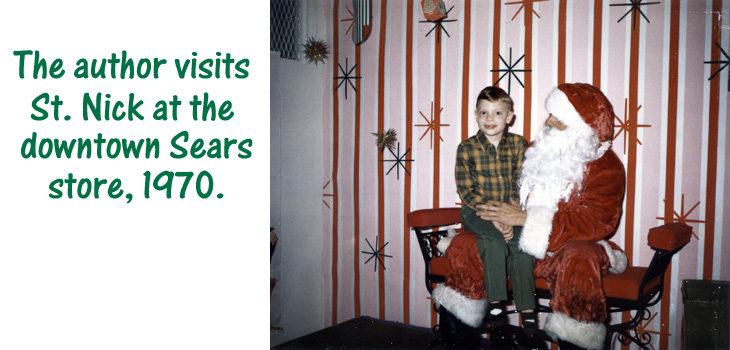O CHRISTMAS TREE Pizitz's auditorium might have been the most dependable place to see Santa's assembly line on demand, but there were a lot of other things going on outside the store's four walls. One of Birmingham's most magnificent traditions was the annual lighting of the giant, living Christmas tree in Woodrow Wilson Park (yeah, I know it is now called Linn Park, but that name was not changed until long after the period we are discussing here). It is difficult to pinpoint just when this ceremony began. It received very little media coverage during the 1950s, and really does not seem to have become an organized celebration until the early 1960s. By 1960 the pattern was set that would be followed for most of the next fifteen years or so: "First the tree will burst into jeweled colors," the newspaper predicted, "then a switch will turn on the thousands of multicolored lights and decorations along 'Santa Claus Lane' extending from Woodrow Wilson Park to Morris Avenue." This spectacular launch of the Christmas shopping season usually took place on the Friday night after Thanksgiving, but it did tend to wander around the calendar over the week or so surrounding that date.
Around the same time the tree lighting was turned on, a more short-lived tradition made its appearance. On 20th Street, a large float depicting Santa's sleigh and reindeer would pull away from the park tree at 7:30 nightly, and carry loads of lucky kids down the busy thoroughfare and back again. Occasionally WBRC-TV personalities such as Benny Carle, Bozo the Clown (played by Bart Darby at that point in history) and the lovely Pat Gray would accompany the kids on their sleigh ride. All of this was well and fine, but it takes on a somewhat different shade when one learns that the individual who came up with the idea -- based on a similar concept he had seen in Los Angeles -- and operated the float was none other than Birmingham's now-infamous police commissioner Bull Connor. Perhaps that explains why this custom did not survive as long as some of the others. By 1963, the year Connor made headlines of the sort no one really wanted, the Downtown Action Committee had gotten into the Christmas spirit, and it was under the DAC's direction by retailer Ferd Weil (of the Vaughan-Weil department store) that the downtown celebrations really shifted into merry chaos. For that year's holiday season, dozens of new and more elaborate street decorations were purchased, and each street and avenue was designated with a different theme. Second Avenue was all aglow as Candle Light Lane; Third Avenue was to be known as Christmas Scroll Lane; 19th Street was Santa Claus Lane, and Christmas carols were the theme song forFirst Avenue. 20th Street was guarded by regiments of toy soldiers, each well over six feet tall.
LET'S HAVE A PARADE In 1966 the DAC came up with a new idea in downtown Christmas celebrations, and paraded it past the citizenry to see whether it would float. Under the headline "City to flip switch... presto, Yule magic!" the newspaper spelled out the details: "The biggest and most colorful one-two holiday punch in Birmingham's history goes into its first half act Friday night as the city lights up its 'living Christmas tree' and bathes all of downtown in a Yuletide glow. It would be a hard act to follow with an encore. But the Downtown Action Committee and the Chamber of Commerce figure to do it with the fanciest animated balloon parade in the Southeast beginning at 7 p.m. Monday."
It was announced that the first giant balloon parade would carry a "Fairyland" theme, with figures representing such classic characters as Peter Pan and Captain Hook, Beauty and the Beast, Snow White and her seven vertically-challenged companions, the Man in the Moon, and most of the Mother Goose crowd. Along with non-literary sights including a 150-foot train with gleaming teeth, there would be some interlopers not normally associated with Christmas, such as a fearsome vampire, Frankenstein's monster, and a dragon that could have been sponsored by the Joy Young restaurant. The platforms would be drawn by Birmingham News carriers and music would be provided by the high school bands from Mountain Brook, Fairfield, Banks, Berry, Hueytown, Tarrant, Carver and Abrams. (Okay, you BIRMINGHAM REWOUND fans -- we just KNOW that there must have been SOME of you who were members of one of the above bands at the time. Didn't anyone's parents shoot photos or home movies of the parade? Didn't they? Hmm?)
The lighting of the new tree went off without any blown bulbs, and the city braced itself for the invasion of the giant balloons. It is obvious that the excitement of this parade was directly dependent on whether one was viewing it as a child or an adult. The next day, the Birmingham News gave an estimate that 100,000 people had lined the sidewalks to watch the parade's inaugural run. Staff writer Hugh Merrill, however, chose to concentrate heavily on how worn-out the balloons appeared. "Loud squeals of snaggled-tooth delight vibrated from taut, unripened vocal chords," he wrote, "and as the brisk wind whipped rosy cheeks into apples, the past-their-prime balloons began to take on the look of magic. At least for the children." Merrill had no trouble finding adults to agree with him, as one lady commented on the decidedly ugly characters, "They have the most horrible expressions on their faces."
Ferd Weil and his cronies didn't have horrible expressions on their faces, though, and the event was deemed enough of a success to make it an annual affair. The 1967 parade was scheduled to be held on a sunny Saturday morning, perhaps in response to the chilly nighttime temperatures of the previous year. The overall theme for that year's balloon figures was built around Bible story personalities -- appropriate enough for Christmas, except that they all originated in the Old Testament, and even then included some rather odd choices such as the notorious Golden Calf.
As it turned out, the best-laid plans of inflated balloon mice and DAC men go oft awry. The Friday night ceremony was washed out by heavy rains and rescheduled for Monday. The white lights to be placed on the trees somehow ran afoul of the city code. "We'll return the 100,000 small Italian lights to Nashville and try to come up with something for next year that will be acceptable to city inspectors," Ferd Weil was quoted as saying, no doubt between clenched teeth that matched those on the balloon figures. At least the parade went over with a bang -- no, maybe that's not the best word to choose when dealing with balloons -- and everyone was happy enough that the 1968 parade was again scheduled for a Saturday morning, this time almost two weeks before Thanksgiving! This time, the theme was the circus, with overblown performing rubber animals and an ersatz Doctor Dolittle, plagiarized from that year's famed movie starring Rex Harrison. And the park finally got its 100,000 white lights in the trees, a sight that transformed the property into an awesome sight, at least for the next several years.
The 1969 parade went back to being held at night. In the past, the balloon characters had been more or less generic in nature, or at least represented public domain literary and fairy tale characters. Nowhere to be found were official, licensed, copyrighted cartoon characters of the type Macy's dealt with. For 1969, there were still no official licensed characters, but that didn't preclude knockoffs from making the scene. With Charles Schulz's Peanuts comic strip at the height of its popularity, the balloon manufacturer decided to risk the wrath of the Red Baron and United Features Syndicate and produce its own phony baloney Peanuts character figures. Just to be sure no one mistook them for the real things, each monstrosity had a mutilated name painted on its rolling wooden platform. You funny paper readers out there surely remember good ol' "Charlie Braun" and his white dog "Snooper," right? What about his friends "Linnus" and "Licy"? There they all were in Birmingham in November 1969, big as life and three times as unnatural.
With that for a grand finale, nothing else was mentioned about the parade in the years that followed (although for 1970, many of the same balloons made the trek up to Anniston to enliven that city's own parade). The tree lighting ceremony strung along for a few more years, but in 1975 the announcement came down that while the tree and park would still be lighted for the season, there would no longer be a planned program connected with it. Festivities were moved to a Saturday morning party at the Alabama Theatre, ostensibly because the nighttime weather was always too unpredictable. As the years rolled by, the tiny white lights in the park trees began to show the effects of age. Since it would have been too much bother to put the lights up and take them down each year, they were left in the trees year round. As the tree limbs grew, the electrical cords were stretched and broken, until by the 1980s someone compared the look of the partially-lighted park to a cornfield after a devastating fire, with only a few barren stalks left. After the park was given a major facelift, the white lights disappeared and the 1966 living Christmas tree was cut down. There is still a tree lighting ceremony these days, but now a tree is trucked in from afar and set up only temporarily for the season. It just isn't the same as being able to see it growing there in March, June, or October. Some of the white lights made a return for the Christmas season of 2004, but not encompassing the entire park as they had done in the past. CHAAAAARRRRGE IT! Although the Chamber of Commerce and its associates took pains to deny it, obviously the main reason for getting so many people downtown for the parades or lighting ceremonies was so they could ultimately become shoppers at the department stores. No one who grew up during downtown's glory days has to be told how spectacular the stores were between Thanksgiving and Christmas, especially the main (or "street") floors, where the most lavish of decorations and displays could be found.
And of course, what would the holiday season have been without the toy departments? So prevalent were toys during the festive time of year that even stores that did not normally stock playthings would have at least a token toy section. We have already seen how Pizitzwisely tied the toy department to the Enchanted Forest, but Loveman's was no slouch either when it came to dragging in the kiddies. For years, Loveman's main contribution to Christmas memories was its "Breakfast With Santa" campaign. On weekday mornings, kids could arrive at the restaurant on the mezzanine to share a meal with the jolly old gift-giver who looked like he didn't miss many meals the rest of the year. TV legend Cousin Cliff Holman was on hand to perform his magic tricks and tell jokes, but Santa's main helper was Twinkles the elf, played yearly by 4'3" Adele (Del) Chambordon of the bookkeeping department. Del has warmly reminisced about making her grand entrance down the marble staircase, belting out "Santa Claus is Comin' to Town" on her accordion.
An odd phenomenon has arisen in the mall Christmas promotions in recent years. Take a look at the various department store Santa photos accompanying this article, then head out for Century Plaza, Brookwood Village, the Galleria, or any of the other malls, and peer over your spectacles at their Santas. The trend in recent years has been for the malls to use Santas who have genuine white whiskers, no longer the huge, fuzzy beards of the past. This is probably a lot easier than trying to keep youngsters from pulling a fake beard off of its rubber band, but the other change is more difficult to explain. WHERE today is Santa's traditional red coat, hat and trousers trimmed in white fur? The mall Santas of 2005 are usually found in long-sleeved dress shirts and multicolored vests, with no hat, and sometimes sporting a long purple robe. If anyone has any inside information from the North Pole as to why Santa has so drastically changed his wardrobe in the last decade or so, please drop us an explanation!
With the former downtown Christmas celebrations moving to the malls and taking on new forms, it is easy to believe that nothing could quite recapture the experiences people over forty years old remember from their childhood. In 1995, freelance Birmingham writer Sara Askew Orr put it well: "Nostalgia plays tricks on our minds. I had such a happy childhood that everything that took place then seems wonderful and great now. I had no deep, dark secrets that were insurmountable. I know that many children did, though. And maybe for those people, the bright lights and colorful decorations at the malls now signify a happier time. "My child may never know the joys of Christmas
downtown. But I hope she will have good memories from where she is now.
I guess that's what we can all hope for: that each generation preserves
some happy memories to share with their children and grandchildren."
Do you have vintage 1960s/1970s photos of any of the Birmingham Christmas traditions mentioned above? Aw, come on, SOMEONE must have been taking pictures in those days! E-mail them to Tim at birminghamrewound dot com! ONWARD TO CHRISTMAS DECORATIONS OF THE PAST....... Text and captions by TIM HOLLIS
GO BACK TO PART ONE This page last updated 07/09/2006
-- 318 PM EDT
|
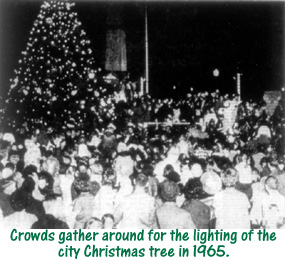
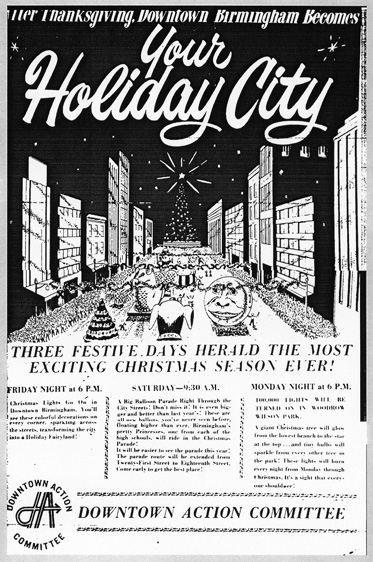 What
exactly was this "animated balloon parade" business? Well, the DAC
had decided to try to out-Macy Macy's with a parade featuring the
same types of gigantic balloon figures so familiar to New Yorkers and those
who watched the festivities on TV annually. The biggest difference was
one that was mentioned only as a footnote in all the pre-parade hype.
Birmingham's streets, with their overhanging power lines and traffic signals,
were not conducive to the floating, helium-filled characters for which
Macy's was so famous. Instead, the balloons seen in the DAC's parade would
be mounted on platforms and wheeled along the parade route.
What
exactly was this "animated balloon parade" business? Well, the DAC
had decided to try to out-Macy Macy's with a parade featuring the
same types of gigantic balloon figures so familiar to New Yorkers and those
who watched the festivities on TV annually. The biggest difference was
one that was mentioned only as a footnote in all the pre-parade hype.
Birmingham's streets, with their overhanging power lines and traffic signals,
were not conducive to the floating, helium-filled characters for which
Macy's was so famous. Instead, the balloons seen in the DAC's parade would
be mounted on platforms and wheeled along the parade route.
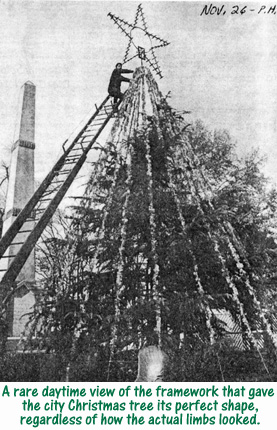 Not
surprisingly, Ferd Weil himself would be grand marshal and lead the head
of the parade. Before that, though, there was the tree lighting ceremony,
and the 1966 event featured something new: the tree itself. It seems that
the original, said to have been planted at the entrance to the park in
1959, had been damaged by the way the lights and ornaments had been attached
to the branches over the past seven years. A new tree was planted for the
1966 festivities, and damage was avoided by covering the tree in a framework
that would hold the lights and decorations, rather than hanging them directly
onto the tree itself. This also produced a more pleasing and triangular
silhouette for the tree when lighted at night.
Not
surprisingly, Ferd Weil himself would be grand marshal and lead the head
of the parade. Before that, though, there was the tree lighting ceremony,
and the 1966 event featured something new: the tree itself. It seems that
the original, said to have been planted at the entrance to the park in
1959, had been damaged by the way the lights and ornaments had been attached
to the branches over the past seven years. A new tree was planted for the
1966 festivities, and damage was avoided by covering the tree in a framework
that would hold the lights and decorations, rather than hanging them directly
onto the tree itself. This also produced a more pleasing and triangular
silhouette for the tree when lighted at night.
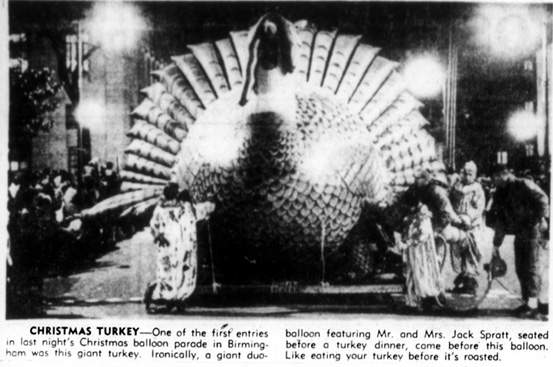
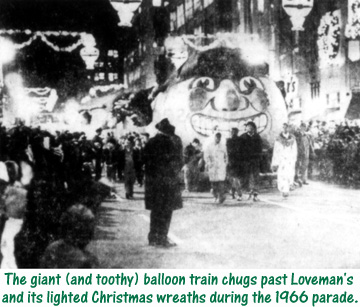
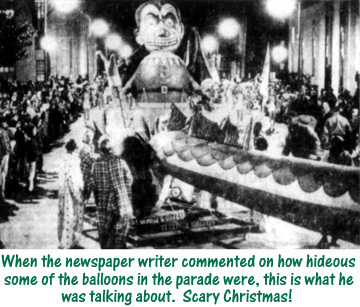
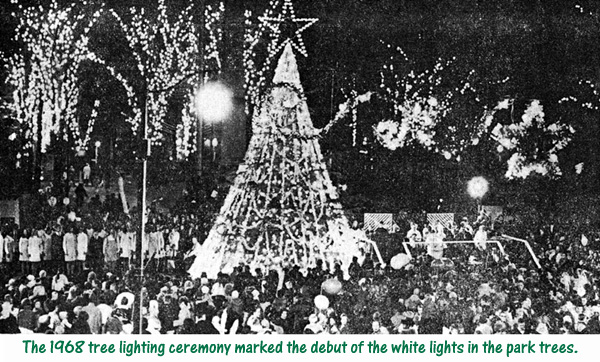
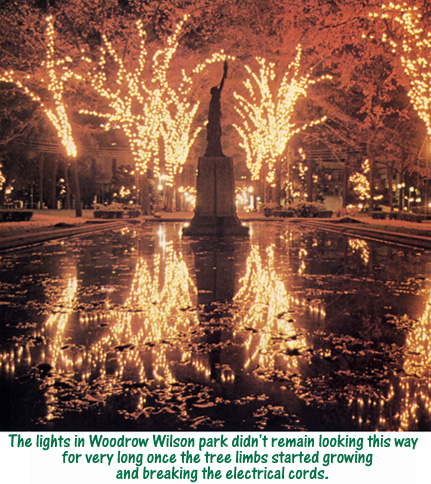
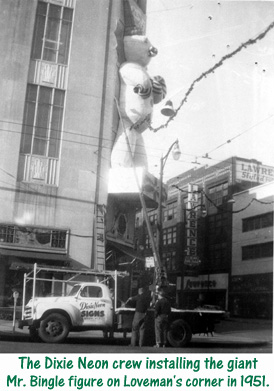 Of
course, by the 1970s most of the traditions we have discussed had moved
to one or another of the area malls. After Loveman's demise, the Breakfast
With Santa club was taken over by Rich's. Several of the malls celebrated
the opening of the holiday season with indoor parades, with costumed cartoon
characters replacing the giant balloons of yesteryear.
Of
course, by the 1970s most of the traditions we have discussed had moved
to one or another of the area malls. After Loveman's demise, the Breakfast
With Santa club was taken over by Rich's. Several of the malls celebrated
the opening of the holiday season with indoor parades, with costumed cartoon
characters replacing the giant balloons of yesteryear.
